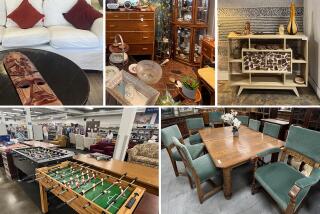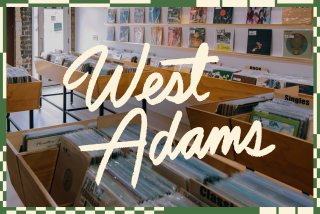SPANISH TREASURES CLOSE AT HAND
- Share via
When we get an authentic colonial piece from Taos or Santa Fe or Old Mexico,” says DeWayne Youts, owner of Umbrello, a furniture showroom and antiques gallery on Melrose Avenue, “it goes out very quickly.” That suggests both the relative rarity of Spanish Colonial furniture and its present popularity. High time, too, because Los Angeles collectors have long overlooked the treasures close at hand.
To collect antique furniture is, among other pleasures, to delight in the past. For some 10 years now, while Los Angeles was assuming its role as international metropolis, the past was perceived almost exclusively in terms of Western Europe and the Orient. Antique furniture was considered of merit only if it came from Italy or England or France, or from Japan or mainland China. As each wave of imports arrived, the city’s native heritage was all but forgotten. Los Angeles was soon a cosmopolitan mix of Italian boutiques and sushi bars, of Petit Trianon living rooms and Art Deco restaurants. Today, however, local collectors are once more looking closer to home--to the heritage of the American Southwest and the Spanish Colonial past.
For 300 years, from the time settlers began to follow in the wake of the conquistadors until the independence of Mexico in 1821, native workers were pressed into service to make furniture for their Spanish masters. “At first it was largely utilitarian,” says Bruce Eicher, whose showroom on Melrose Avenue specializes in antiques and reproductions of the period. “The Spaniards ordered simple pieces based on European models--tables, benches, kitchen cabinets--to be used until their own furniture arrived from Spain, which could take a year or more.
“Yet, even though they weren’t professional, the hacienda workers were skillful and artistic,” Eicher says. “It’s really very fortunate they were more or less amateurs. That’s what makes their furniture so simple, clean and rugged. And they used the most beautiful woods.”
The furniture was appropriate, since the usual Spanish Colonial house had clean and simple lines, too: thick adobe walls with rounded corners and bare tile floors. In the ordinary estate house there was very little furniture, since the climate called for bareness and coolness. The furniture made by local workers conformed in every way. Ornamentation was modest, and the pieces were, above all, utilitarian.
Dining rooms contained little more than chairs and a long table with a heavy top. Kitchens had wooden boxes to hold grain and firewood, simple tables and chairs, and often a trastero for storing dishes and glassware. Today, these chairs and tables are reasonably plentiful. The trastero , a tall cabinet with doors, also is one of the more common pieces available. It comes in many variations of color and decoration, depending on whether it is from Santa Fe, Taos or Mexico.
More sophisticated, and more difficult to find in the antiques market, are the large bedroom roperos --the equivalent of European armoires. Many have rosettes and geometric designs carved on the doors, and many are made of sabino wood, the Mexican cypress with a pale golden tint. Mesquite is another wood used extensively. It is commonly found in antique chests with scratch-and-gouge carvings, heavy locks and iron corner reinforcements, as well as in Spanish-style benches with shaped slats. The largest pieces available on the local antiques market are from churches and were used for storing vestments and chalices. Some of these are truly monumental, and an entire room could be designed around them.
A word of caution about these antiques, however. In Mexico today a type of reproduction furniture--known as rustico --is being made; the makers use old wood and pieces from authentic antiques. If you’re not a purist, you may be satisfied with its looks , but if you want authenticity, too, you’d be wise to seek professional advice.
The charm that Spanish Colonial furniture holds lies in its simplicity, in the fact that it interacts so well with contemporary decor, and in its appropriateness to Southern California. Even when the furniture is large, it seems light and graceful. It is nothing like the heavy Mission furniture of the 1920s and 1930s, which surfaced when a revival of Spanish Colonial architecture flourished in the Southwest. As Palm Springs interior designer Steve Chase says: “The simpler examples of colonial furniture blend well in any contemporary interior. The large scale of many of the pieces, much larger than European equivalents, complements the architectural scale and size of Southwest houses.”
It is encouraging to report that local collectors are finally looking away from European and Oriental antiques. They are discovering something of rare value from the unhurried days of the Spanish Colonial haciendas, when land--and time--seemed infinite, and even the simplest furniture was made to last.


